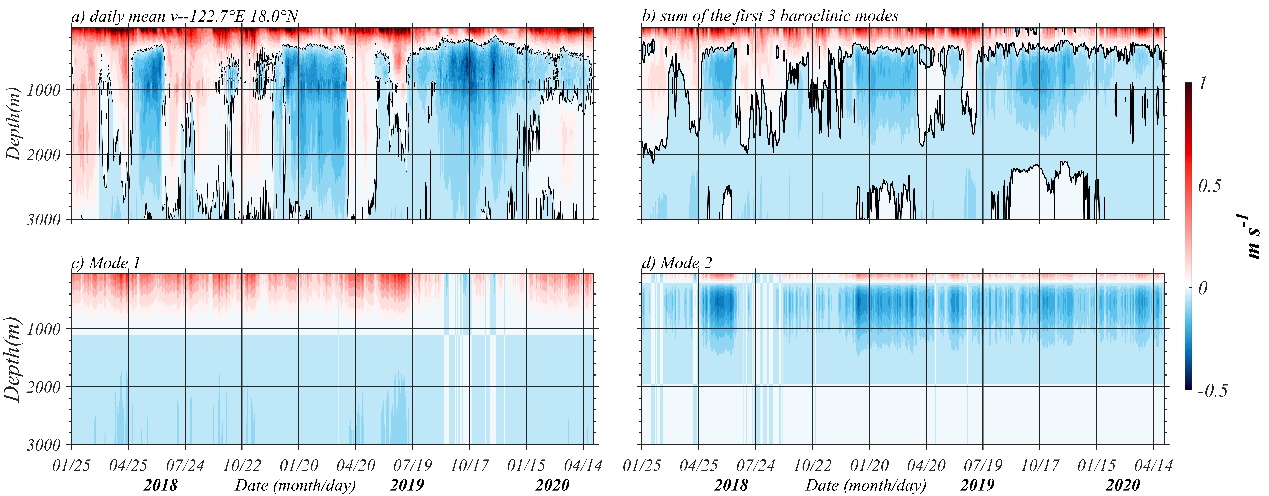There might be a southward-flowing undercurrent beneath the Kuroshio at its origin off the east coast of Luzon Island, named Luzon Undercurrent (LUC).
The low-latitude western boundary current system in the North Pacific Ocean, including the upper layer northward Kuroshio and the underlying southward LUC, plays an important role in climate and marine ecosystem both within the region and in other sectors of the globe, because of its huge transports of heat and water masses.
Recently, an international team led by Prof. HU Shijian from the Institute of Oceanology, Chinese Academy of Sciences (IOCAS), uncovered the spatial structure and variability of the western boundary currents east of Luzon Island using continuous direct measurements from a mooring array.
The study was published in Journal of Geophysical Research: Oceans on Feb. 1.
"It was a question whether the LUC is a transient phenomenon or permanent current, and more solid observational evidences are needed," said Dr. MA Jie.
Researchers deployed a mooring array for the first time in the east of Luzon Island through international cooperation and successfully captured the variability of the western boundary currents.
Based on nearly 29 month measurements collected by acoustic Doppler current profilers (ADCPs) from three moorings between January 2018 and May 2020, researchers found the southward velocity of LUC has a maximum greater than 0.04 m s-1 at about 800 m on average, which suggested that the LUC is a permanent mean undercurrent.
Observations indicate that the LUC and Kuroshio have significant intraseasonal variability and the LUC is reversed occasionally. A cyclonic eddy tends to force a stronger LUC, while the strong upper-layer anticyclonic eddy is suggested to play a key role in the attenuation and reversal of LUC.
Vertical mode decomposition analysis shows that the first two baroclinic modes explain the main vertical features of the LUC and Kuroshio at its origin. No reversal of the southward undercurrent occurs in the second baroclinic mode velocity.
"The LUC variability is generally a result of the second baroclinic mode, but the observed reversal of the LUC is mainly caused by the first mode," said Prof. HU.
These results provide direct and key evidence to better understand the western boundary current system in the North Pacific Ocean.

Fig. 1 (a) Time series of daily averaged meridional currents observed by mooring at 18°N, 122.7°E. Composites of sea level anomaly (shaded) and surface geostrophic currents (vectors) to (b) the weak LUC events and (c) the strong LUC events. (d) As in (b) and (c), but depicts the time-mean sea level anomaly and currents during the observation period.

Fig. 2 (a) Time series of daily mean meridional velocity measured by the mooring at 18°N, 122.7°E. Reconstruction based on the meridional velocity projected onto (b) sum of modes 1-3, (c) mode 1, and (d) mode 2.
Ma, J., Hu, S.*, Hu, D., Villanoy, C.,Wang, Q., Lu, X., & Yuan, X. (2022). Structure and variability of the Kuroshio and Luzon Undercurrent observed by a mooring array. Journal of Geophysical Research: Oceans, 127, e2021JC017754.
HU Shijian
Institute of Oceanology
E-mail: sjhu@qdio.ac.cn
(Editor: ZHANG Yiyi)
|
|

Address: 7 Nanhai Road, Qingdao, Shandong 266071, China
Tel: 86-532-82898902 Fax: 86-532-82898612 E-mail: iocas@qdio.ac.cn


